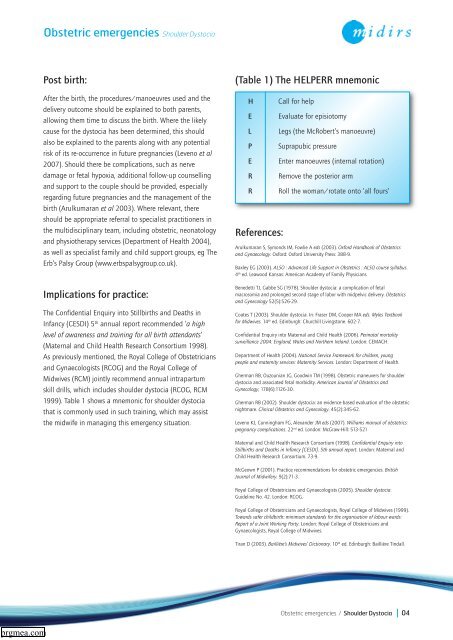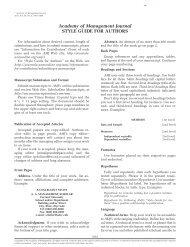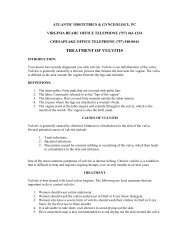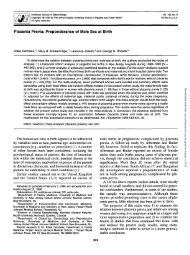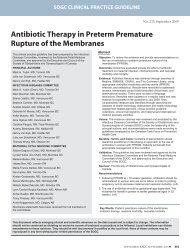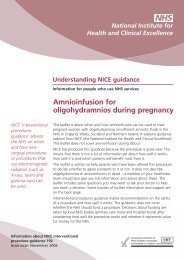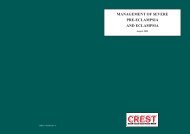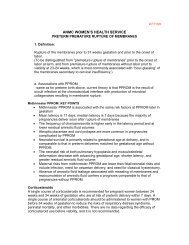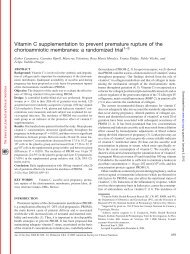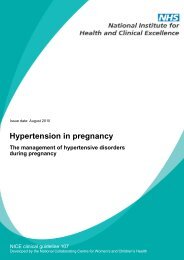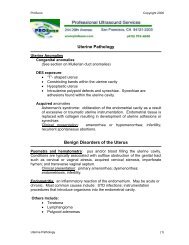Shoulder Dystocia
Shoulder Dystocia
Shoulder Dystocia
Create successful ePaper yourself
Turn your PDF publications into a flip-book with our unique Google optimized e-Paper software.
Obstetric emergencies <strong>Shoulder</strong> <strong>Dystocia</strong><br />
Post birth:<br />
After the birth, the procedures/manoeuvres used and the<br />
delivery outcome should be explained to both parents,<br />
allowing them time to discuss the birth. Where the likely<br />
cause for the dystocia has been determined, this should<br />
also be explained to the parents along with any potential<br />
risk of its re-occurrence in future pregnancies (Leveno et al<br />
2007). Should there be complications, such as nerve<br />
damage or fetal hypoxia, additional follow-up counselling<br />
and support to the couple should be provided, especially<br />
regarding future pregnancies and the management of the<br />
birth (Arulkumaran et al 2003). Where relevant, there<br />
should be appropriate referral to specialist practitioners in<br />
the multidisciplinary team, including obstetric, neonatology<br />
and physiotherapy services (Department of Health 2004),<br />
as well as specialist family and child support groups, eg The<br />
Erb’s Palsy Group (www.erbspalsygroup.co.uk).<br />
Implications for practice:<br />
The Confidential Enquiry into Stillbirths and Deaths in<br />
Infancy (CESDI) 5 th annual report recommended ‘a high<br />
level of awareness and training for all birth attendants’<br />
(Maternal and Child Health Research Consortium 1998).<br />
As previously mentioned, the Royal College of Obstetricians<br />
and Gynaecologists (RCOG) and the Royal College of<br />
Midwives (RCM) jointly recommend annual intrapartum<br />
skill drills, which includes shoulder dystocia (RCOG, RCM<br />
1999). Table 1 shows a mnemonic for shoulder dystocia<br />
that is commonly used in such training, which may assist<br />
the midwife in managing this emergency situation.<br />
(Table 1) The HELPERR mnemonic<br />
H<br />
E<br />
L<br />
P<br />
E<br />
R<br />
R<br />
References:<br />
Call for help<br />
Evaluate for episiotomy<br />
Legs (the McRobert’s manoeuvre)<br />
Suprapubic pressure<br />
Enter manoeuvres (internal rotation)<br />
Remove the posterior arm<br />
Roll the woman/rotate onto ‘all fours’<br />
Arulkumaran S, Symonds IM, Fowlie A eds (2003). Oxford Handbook of Obstetrics<br />
and Gynaecology. Oxford: Oxford University Press: 388-9.<br />
Baxley EG (2003). ALSO : Advanced Life Support in Obstetrics : ALSO course syllabus.<br />
4 th ed. Leawood Kansas: American Academy of Family Physicians.<br />
Benedetti TJ, Gabbe SG (1978). <strong>Shoulder</strong> dystocia: a complication of fetal<br />
macrosomia and prolonged second stage of labor with midpelvic delivery. Obstetrics<br />
and Gynecology 52(5):526-29.<br />
Coates T (2003). <strong>Shoulder</strong> dystocia. In: Fraser DM, Cooper MA eds. Myles Textbook<br />
for Midwives. 14 th ed. Edinburgh: Churchill Livingstone. 602-7.<br />
Confidential Enquiry into Maternal and Child Health (2006). Perinatal mortality<br />
surveillance 2004: England, Wales and Northern Ireland. London: CEMACH.<br />
Department of Health (2004). National Service Framework for children, young<br />
people and maternity services: Maternity Services. London: Department of Health.<br />
Gherman RB, Ouzounian JG, Goodwin TM (1998). Obstetric maneuvers for shoulder<br />
dystocia and associated fetal morbidity. American Journal of Obstetrics and<br />
Gynecology, 178(6):1126-30.<br />
Gherman RB (2002). <strong>Shoulder</strong> dystocia: an evidence-based evaluation of the obstetric<br />
nightmare. Clinical Obstetrics and Gynecology. 45(2):345-62.<br />
Leveno KJ, Cunningham FG, Alexander JM eds (2007). Williams manual of obstetrics:<br />
pregnancy complications. 22 nd ed. London: McGraw-Hill: 513-521<br />
Maternal and Child Health Research Consortium (1998). Confidential Enquiry into<br />
Stillbirths and Deaths in Infancy [CESDI]. 5th annual report. London: Maternal and<br />
Child Health Research Consortium. 73-9.<br />
McGeown P (2001). Practice recommendations for obstetric emergencies. British<br />
Journal of Midwifery. 9(2):71-3.<br />
Royal College of Obstetricians and Gynaecologists (2005). <strong>Shoulder</strong> dystocia.<br />
Guideline No. 42. London: RCOG.<br />
Royal College of Obstetricians and Gynaecologists, Royal College of Midwives (1999).<br />
Towards safer childbirth: minimum standards for the organisation of labour wards:<br />
Report of a Joint Working Party. London: Royal College of Obstetricians and<br />
Gynaecologists, Royal College of Midwives.<br />
Tiran D (2003). Baillière’s Midwives’ Dictionary. 10 th ed. Edinburgh: Baillière Tindall.<br />
Obstetric emergencies / <strong>Shoulder</strong> <strong>Dystocia</strong> 04<br />
prgmea.com


